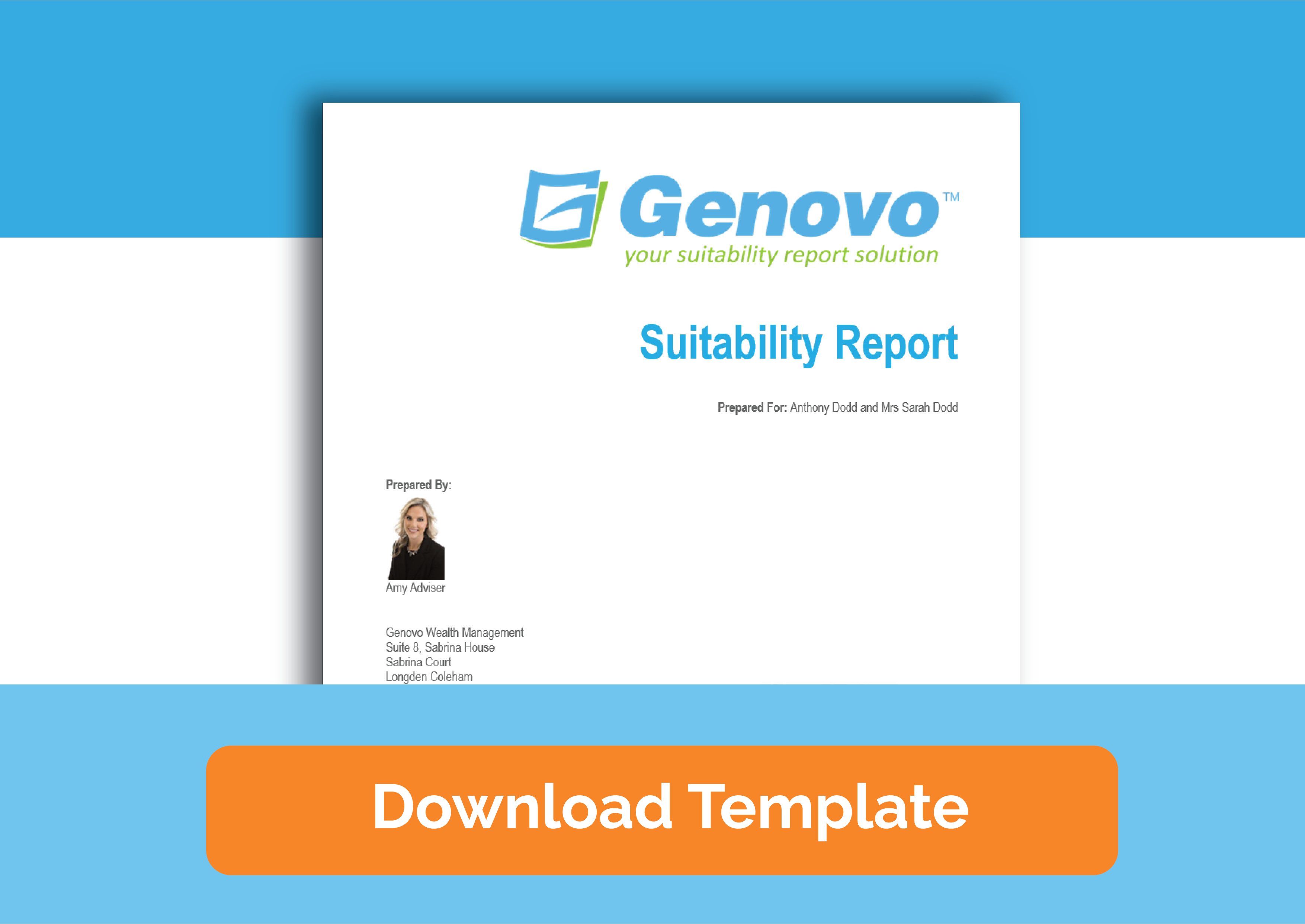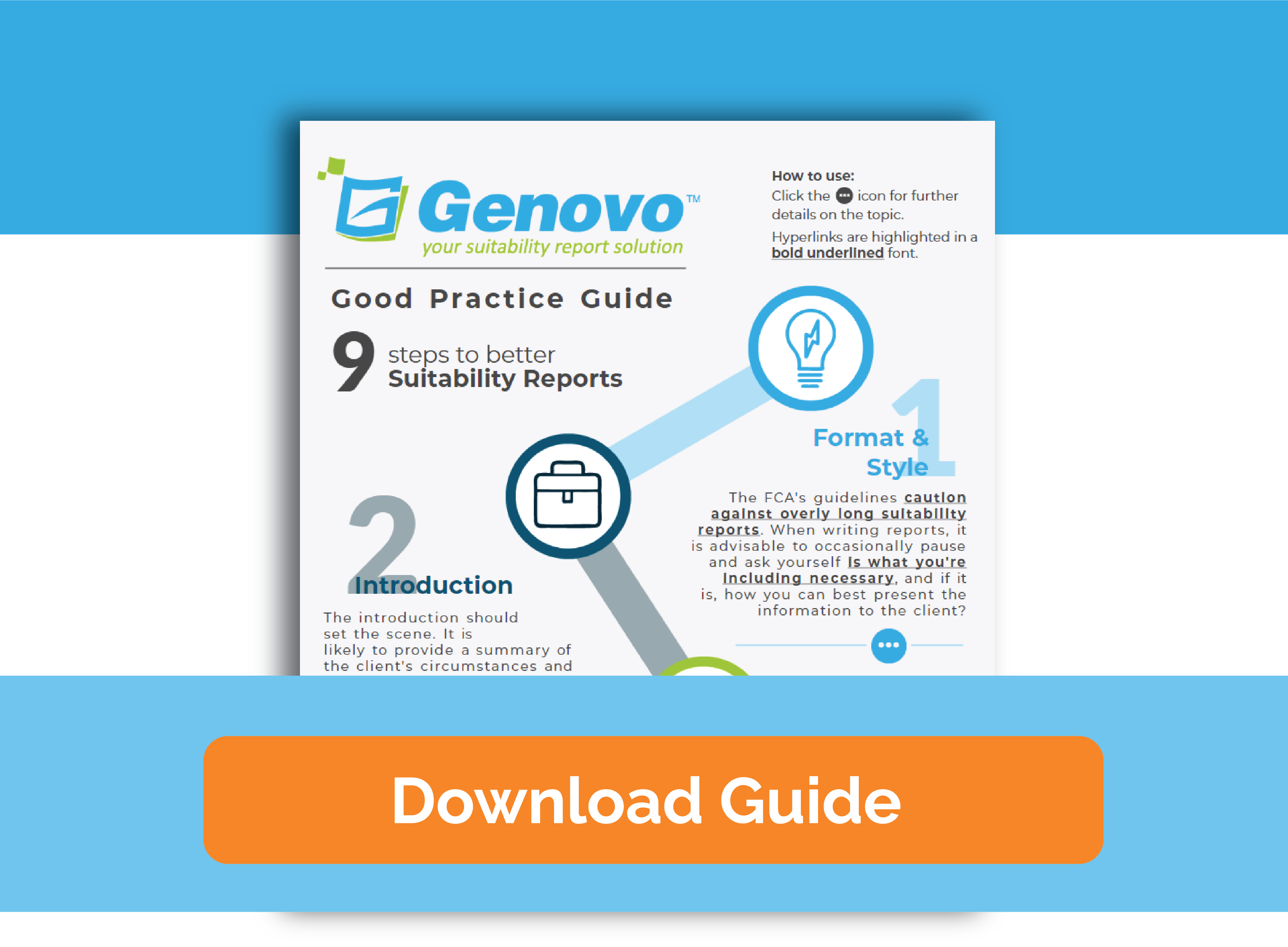
Client Objectives in Suitability Reports: What the FCA Expects of You
Ed Evans
Given the recent comments made by Rory Percival, the FCA’s technical specialist, at the Thesis Asset Management conference where he warned against an increased standardisation of the advice process, and was quoted as saying:
“..don’t have any template client objectives in suitability reports. That is the best defence against us, the Financial Ombudsman Service and complaints.”
I thought this would be an ideal time to recap on our understanding of what the regulator expects from you in this area, and explain how the Genovo suitability report app deals with the issues raised.
To be honest what he said is nothing new. Ever since the regulator issued their original Suitability Report Factsheet back in November 2011, they’ve suggested it’s good practice within a suitability report to:
“…Give a clear summary of the customer’s objectives, needs, priorities and relevant existing investments, demonstrating the adviser had taken account of these….”
And this was highlighted again in the FCA’s revised Suitability Report Factsheet which was reissued in September of last year.
At the conference, Mr Percival was then quoted as going on to say:
“One of the areas of concern is that there is the potential for increased standardisation process to result in a lack of personalisation…..we are looking at the files and seeing standard objectives across different clients and those objectives are solution-based rather than client-based.”
So what does he mean by this? At this stage, I should declare that I’ve never had the opportunity to ask Mr Percival in person so I may well be wrong on this, but I think what he’s saying is that clients don’t typically articulate their objectives with the same standard phrases like “I want to take the tax free cash from my pension and use drawdown to access the remaining fund.” I guess this would be an example of what he calls a “solution-based objective”.
A client might however say “I need £20,000 to pay for my daughter’s wedding and a further £20,000 to fund a once in a lifetime trip around the world. I also need advice on how best to fund any shortfall in my income moving forward as I plan to wind down my work commitments following my travels. ” Although both may ultimately result in the same recommendation(s), the later I believe is a better example of a “client-based objective”.
Ever since we launched Genovo we’ve recognised the importance of including personalised objectives in suitability reports and advised against relying on generic, stock statements that frequently remain unchanged. Therefore within the Client Objectives step of the Introduction Section of the Genovo Report Builder you are prompted to personalise the wording of each selected objective and add comprehensive Know Your Client (KYC) information to it. The idea being that this KYC information should create a clear link between the client’s specific objective(s) and the advice reasons selected in the recommendation sections, which in turn will help support the suitability of the product(s) you’re recommending.
It’s easy to add KYC info to an objective within Genovo, simply click the add KYC info link to the right of the selected objective as per the screenshot below.

On clicking the link you’ll be directed to a new page where you’ll be prompted to customise the wording of the objective, add KYC info and assign a display order to it – this will determine the order the selected objectives are displayed in your report.

Listing the objectives in their order of priority to the client not only reflects FCA suggested good practice, but also reassures the client that you appreciate what’s really important to them.
It’s important to remember that even if a client only appears to have one “solution-based objective” (e.g invest a capital lump sum), they are in reality likely to have a number of “client-based objectives”. Here’s an example of what I mean.
Review your expenditure and income needs
Since retiring you have noticed that you are “slowly eating into your savings”, which has not been helped by the additional financial commitment involved in putting your son through university. Having undertaken some cashflow modelling, I have calculated that your outgoings currently exceed your combined net income by just under £4,000 each year. However, assuming your costs remain broadly the same, this shortfall will be more than covered by your State Pension which you will start to receive from June 2017.
Invest a lump sum to provide an income
You currently have £120,000 invested in various deposit-based accounts. You wish to retain £20,000 within your current account to act as an emergency fund, but would like to invest the residual £100,000 to alleviate your current income shortfall, whilst protecting the underlying capital. You have specifically requested that the income is paid monthly.
Review your existing investments
You have asked for my advice regarding an endowment plan you took out with Legal & General many years ago in connection with your mortgage. If appropriate, you have also requested that I put forward a recommendation for the reinvestment of these monies.
Minimise the cost of investment
Having discussed active and passive fund management, you preferred the idea of passive fund management as this will help keep the associated investment costs to a minimum.
I hope you’d agree that separating out the objectives and embellishing them with the clients own words and more detailed information regarding their current income shortfall, their desire to receive a monthly income and keep investment costs to a minimum not only helps personalise the report, but also clearly justifies why an investment product which provides a flexible monthly income and invests in passive funds has been recommended – a win-win for all concerned!
Ok that’s it for this week – I hope you’ve found that useful. Please feel free to leave a comment below, and if you don’t want to miss out on our future posts – subscribe using the subscribe via email form at the top right of this page, and get email alerts when we post.
Image courtesy of bplanet / FreeDigitalPhotos.net


We don’t write suitability reports for the benefit of the FCA or FOS. We write them for the benefit of our clients. They are designed to explain to a client why the advice we are delivering to them is suitable for their needs and wants. to make sure that they are understandable we write them in plain English
Our suitability reports are designed as discussion documents and are presented to clients so that they can ask, and have answered, any quetsions that arise.
We do use some standard paragraphs where they are useful. Thes eprovide consistency in our explanation of technical points. Despite the regulatory desire not to use “templates” we do use them because it means we can structure the reports in a logical fashion and walk our clients thorugh a suitable series of explanatory steps. The FCA should not confuse “template” with lack of personalisation those are different things.
The worst part of our suitability letters are the illustrations and keyfacts appendices. If the regulator really wants to improe the quality and output of suitability reports and letters they would do well to look at their requirements for illustrations which are i am afraid pretty useless and rarely read (and if they are rarely understood) by real human beings
Hi Nick
Thanks for your comment. I completely agree that it’s all too easy to lose sight of who the suitability report is being written for, and I would certainly champion the use of plain English and visually engaging content wherever possible.
As for the difference between templates and lack of personalisation – I think you’re spot on. However, being fair to the FCA, I don’t believe they’re saying don’t use templates or template wording, just not the same standard objectives time and again e.g “the investment of a lump sum for capital growth”. As Mr Percival later tweeted “I only said objectives should be personal to the client and not solution-focused. Imagine what would happen if I said anything controversial”